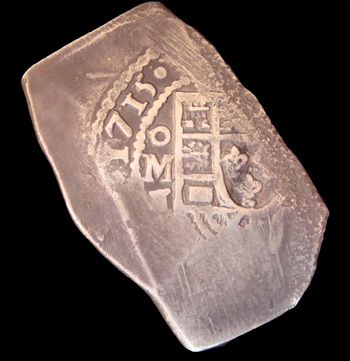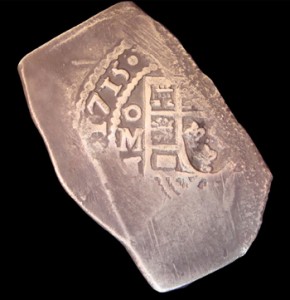The 1715 Fleet Society wishes to launch a discussion on grading Spanish Colonial cobs. This, our first sailing on the stormy sea of grading, will focus specifically on grading Mexican silver cobs (1536-1733). Other mints and other cob series will be visited in the sequels. We invite collectors of Mexican cobs to take the brief survey available here and send us any comments. We want and need your input! A future posting will discuss the results of this survey.
After an initial attempt to produce a round, well struck silver coinage, the Mexico City mint began to produce silver cobs that were increasingly irregular in shape and poorly struck. By the reign of Charles II and his Bourbon successor Philip V, it was not uncommon for a Mexican cob to be very oddly shaped, display no legends at all, and have less than half of the designs struck up. The question, simply stated, is how to grade such a coinage. Several grading systems have been developed that seems to do a satisfactory job with modern milled or machine-struck coinage.
Sheldon grading, using the familiar AG 1 – MS 70 scale, was originally designed to apply to the machine-struck coinage produced by the US Mint after 1792. It has since been extended in a straightforward way to various non-US coinages such as the milled Pillar or Columnario silver coinage struck in Mexico City beginning in 1732. The extension of Sheldon grading to hand-struck, irregular silver cobs is not at all straightforward. The problem is complicated by the fact many (if not most) Mexican silver cobs have been recovered from the ocean and show a range of effects from their immersion. Some still attractive Mexican 8 reales recovered from 1715 Fleet, for example, are found to be as much 5% underweight without showing any conspicuous wear or corrosion. Perhaps weight loss in the ocean was compounded by a planchet that was already 2-3% below standard. Silver planchets were not individually adjusted at Mexico City.
How then do we apply Sheldon grading to an underweight but not visibly corroded ocean cob that has no wear from circulation? Is it a mint state coin? Suppose only 60% of its shield and cross are struck up? This is just one set of the issues that arise in trying to adapt Sheldon grading to Mexican silver cobs. The major grading services now do assign Sheldon numbers to Spanish Colonial cobs, but it is not at all clear what XF 45 or AU 53 or MS 61 is supposed to represent when applied to Mexican silver cobs. It has been suggested that Sheldon grading is not the right approach to grade Spanish Colonial cobs.


